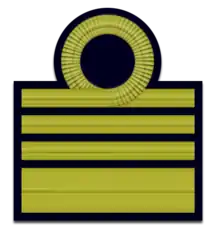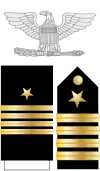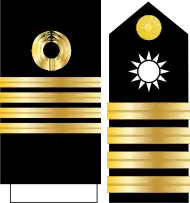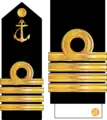Captain (naval)
Captain is the name most often given in English-speaking navies to the rank corresponding to command of the largest ships.[1][2][3] The rank is equal to the army rank of colonel.

| Naval officer ranks |
|---|
| Flag officers |
| Senior officers |
| Junior officers |
Equivalent ranks worldwide include Ship-of-the-line captain (e.g. France, Argentina, Spain), Captain of sea and war (e.g. Brazil, Portugal), Captain at sea (e.g. Germany, Netherlands) and "Captain of the first rank" (Russia).
The NATO rank code is OF-5, although the United States of America uses the code O-6 for the equivalent rank (as they do for all OF-5 ranks).
Etiquette
Any naval officer who commands a ship is addressed by naval custom as "captain" while aboard in command, regardless of his actual rank, even though technically an officer of below the rank of captain is more correctly titled the commanding officer, or C.O. Officers with the rank of captain travelling aboard a vessel they do not command should be addressed by their rank and name (e.g., "Captain Smith"), but they should not be referred to as "the captain" to avoid confusion with the vessel's captain.[4] The naval rank should not be confused with the army, air force, or marine ranks of captain, which all have the NATO code of OF-2.[Note 1]
US Navy traditions
On large US ships (e.g., aircraft carriers), the executive officer (XO) may be a captain in rank, in which case it would be proper to address them by rank. Often the XO prefers to be called "XO" to avoid confusion with the CO, who is also a captain in rank and the captain of the ship.[5] The same applies to senior commanders on board US aircraft carriers, where the commander and deputy commander of the embarked carrier air wing are both captains in rank, but are addressed by the titles of "CAG" and "DCAG", respectively.
Commands
Captains with sea commands generally command ships of cruiser size or larger; the more senior the officer, the larger the ship, but ship commanders do not normally hold a higher rank than captain. In the Royal Navy, a captain might command an aircraft carrier, an amphibious assault ship, or the Ice Patrol Ship, while naval aviator and naval flight officer captains in the U.S. Navy command aircraft carriers, large-deck amphibious assault ships, carrier air wings, maritime patrol air wings, and functional and specialized air wings and air groups.
Maritime battlestaff commanders of one-star rank (commodores or rear admirals lower half) will normally embark on large capital ships such as aircraft carriers, which will function as the flagship for their strike group or battle group, but a captain will retain command of the actual ship, and assume the title of "flag captain". Even when a senior officer who is in the ship's captain's chain of command is present, all orders are given through the captain.
By country
Austro-Hungarian Empire
Linienschiffskapitän (Ship-of-the-line-captain) was an officer rank in the Austro-Hungarian Navy, equivalent to Oberst in the land forces or Kapitän zur See in the Kaiserliche Marine. It is still partly used by the navies of the Empire's successor states, such as Yugoslavia and Croatia.
In descending order, the other officer ranks below Linienschiffskapitän were
- Frigate captain (Oberstleutnant in the land forces)
- Corvette captain (Major in the land forces)
- Ship-of-the-line lieutenant (Hauptmann in the land forces)
- Frigate lieutenant (Oberleutnant in the land forces)
- Corvette lieutenant (Leutnant in the land forces)
Belgium
In the Belgian Navy the rank of capitaine de vaisseau or kapitein-ter-zee is the third grade of superior officer, equivalent to colonel in the land forces. Its insignia is made up of four bands. He or she commands a capital ship (cruiser, battleship or aircraft carrier) or a shore establishment. Smaller vessels such as destroyers and frigates are commanded by a kapitein-luitenant.
Canada
In the Canadian Armed Forces, Captain(N) (French: capitaine de vaisseau, capv) is a rank for officers who wear navy uniform, equal to colonel for officers who wear army or air force uniform. Like colonel, captain(N) is the highest rank of senior officer. A captain(N) is senior to a commander or a lieutenant-colonel, and junior to a commodore or brigadier-general.
Typical appointments for captains(N) include:
- Commanding officer of a Canadian Forces base;
- Commanding officer of a large school or research establishment, such as the Canadian Forces Maritime Warfare Centre;
- Commanding officer of a Protecteur-class auxiliary vessel;
- Chief of staff of a formation staff, or a director-general position on an administrative staff;
- Foreign military attaché.
The rank insignia for a captain(N) is four 1⁄2-inch (1.3 cm) stripes, worn on the cuffs of the service dress jacket, and on slip-ons on other uniforms. On the visor of the service cap is one row of gold oak leaves along the edge. Captains(N) wear the officers' pattern branch cap badge.
The "(N)" is a part of the rank descriptor, and is used in official publications and documents to distinguish a captain(N) from a captain in the army or air force. It is also important to distinguish between the rank of captain(N) and the appointment of captain, meaning the commanding officer of a ship, regardless of his or her rank.
A captain(N) is addressed initially as "Captain Bloggins", thereafter by superiors and peers as "Captain" and by subordinates as "Sir" or "Ma'am". The "(N)" is not part of the spoken address.
Note: Before Unification of the Canadian Forces in 1968, rank structure and insignia followed the British pattern.
- Navy uniform variations
 Dress uniform tunic
Dress uniform tunic_DEU(RANKSLIDE).png.webp) Uniform shirts
Uniform shirtsMess.PNG.webp) Shoulder boards for short-sleeve shirt and tropical white tunic
Shoulder boards for short-sleeve shirt and tropical white tunic.png.webp) CADPAT uniform (-2010)
CADPAT uniform (-2010)
- Mess uniform variations
 Number 2 mess uniform
Number 2 mess uniformMess.PNG.webp) Number 2A summer mess white uniform shoulder boards
Number 2A summer mess white uniform shoulder boards.png.webp) Shoulder boards for the Number 2C shipboard mess uniform (1968-2010).
Shoulder boards for the Number 2C shipboard mess uniform (1968-2010)..svg.png.webp) Sleeve number 2D Canadian Forces mess standard for members that have joined the CF before 1987 (1968-2010).
Sleeve number 2D Canadian Forces mess standard for members that have joined the CF before 1987 (1968-2010).
Estonia
France

Capitaine de vaisseau is a rank in the French Navy, corresponding to that of colonel in the French Army. They usually command the navy's most important ships.
He has five stripes and is addressed as "commandant". In naval slang, he is also known as a "cap' de veau".
Germany
Kapitän zur See (abbreviated KptzS, KZS, or KzS) ("Captain at sea") is the highest senior officer rank in the German Navy.[6]
Address
The official manner, according to ZDv 10/8, of formal addressing of military people with the rank Kapitän zur See is "Herr/Frau Kapitän zur See". However, in German naval tradition a Kapitän zur See will be addressed as "Herr/Frau Kapitän", or, often, in seamen's language "Herr/Frau Kap'tän".
Rank insignia and rating
| ||||
| NATO equivalent | OF-5 | |||
The rank insignia of a Kapitän zur See (Captain at sea), worn on the sleeves and shoulders, is a five-pointed star above four stripes when worn on the sleeve. When worn as rank loops, typically on the shoulder, the star is omitted.
The rank is rated OF-5a[7] in NATO, and is equivalent to Oberst in the Heer and Luftwaffe. It is grade A16 or B3 in the pay rules of the Federal Ministry of Defence and is senior to the OF-4 rank of Fregattenkapitän.
Volksmarine


Kapitän zur See in the Volksmarine of the GDR was the highest grade of the senior officer's rank group, comparable to NATO-rank code OF-5. The rank insignia consisted of shoulder strap and sleeve stripes. Shoulder straps had to be worn on uniform jackets and consisted of twisted silver braids with three gold pips on padding in a navy blue colour.
Cuff insignia consisted of one big stripe, and a five-point naval star above. In contradiction of Imperial German Navy tradition, where sleeve rings encircled the lower cuffs, the Volksmarine cuff strips formed 40% rings.
Imperial German Navy and Kriegsmarine


insignia
In the Imperial German Navy and Kriegsmarine, Kapitän zur See was the highest officer rank of the senior officer´s rank group. The rank insignia consisted of shoulder strap and sleeve stripes. Shoulder straps had to be worn on uniform jackets and consisted of twisted silver braids with two gold pips (stars) on padding in navy blue colour. Cuff insignia consisted of four stripes, and a five-point naval star above. The sleeve rings encircled the lower cuffs.
| junior rank Fregattenkapitän |
(Ranks Kriegsmarine) Kapitän zur See Oberst |
senior rank Kommodore |
Italy

The rank of Captain (Italian: capitano di vascello, lit. "naval vessel captain") also exists in the Italian Navy. He is addressed as "comandante".
Netherlands
In the Royal Netherlands Navy, the rank of kapitein-ter-zee is the third grade of superior officer, equivalent to colonel in the land-forces. His insignia is made up of four bands and he commands a capital ship or a shore establishment (until recently, a kapitein-ter-zee commanded the Onderzeedienst and Mijnendienst, the Netherlands Navy's submarine and mine-laying training establishments).
Smaller vessels such as destroyers and frigates are commanded by a kapitein-luitenant ter zee. Until recently flagships such as Tromp-class frigates were also commanded by a kapitein-ter-zee. Currently, De Zeven Provinciën-class frigates are commanded by a kapitein-luitenant-ter-zee.
Portuguese-speaking navies
Captain of sea and war (Portuguese: capitão de mar e guerra) is a rank in a small number of Portuguese-speaking navies, notably those of Portugal and Brazil, which corresponds to the rank of ship-of-the-line captain, or the US and Commonwealth rank of captain.
The term captain of sea and war, like the modern rank of ship-of-the-line captain in the navies of France, Italy, and Spain, has deep historic roots. Although the rank was first formally established in the 17th century, the expression had been sometimes been used in the Portuguese and Spanish (as Capitán de Mar y Guerra) armadas of the 16th century. But generally, in the 16th and early 17th centuries, the captain of a Portuguese man-of-war was simply called a capitão, while the commander of a fleet was termed capitão-mor, literally "captain-major".
During the 16th century, the term almirante was used in Portugal to designate the second in command of a fleet. Only during the 18th century would it come to designate the fleet commander - an admiral in the more modern sense. But during the latter half of the 17th century, the term "captain of sea and war" came to designate the commander of a larger man-of-war - the ship of the line that began evolving at that time. When that happened, the Portuguese Navy, as other navies, came to use the term capitão de fragata and capitão-tenente, literally "frigate captain" and "captain-lieutenant", to designate the commanders of smaller warships. When Brazil gained her independence from Portugal in 1822, its navy adopted the Portuguese rank denominations, which both countries still use.
Today, the rank of captain of sea and war exists in the navies of Portugal, Brazil, Angola, Mozambique and Guinea-Bissau.
 Rank insignia of a Portuguese captain of sea and war, worn on the lower sleeve
Rank insignia of a Portuguese captain of sea and war, worn on the lower sleeve Rank insignia of a Brazilian captain of sea and war, worn on the lower sleeve
Rank insignia of a Brazilian captain of sea and war, worn on the lower sleeve Front page of the Breve Compendio do que pertence à obrigação de hum Capitão de Mar, & Guerra, or "Brief compendium of what pertains to the obligation of a captain of sea and war" (1676)
Front page of the Breve Compendio do que pertence à obrigação de hum Capitão de Mar, & Guerra, or "Brief compendium of what pertains to the obligation of a captain of sea and war" (1676)
Russia and Ukraine
(Russia:Капитан первого ранга)(Ukraine:Капитан первого ранга)
United Kingdom
United States
Other countries
Equivalent titles in other countries include:
- Croatia - Kapetan bojnog broda
- Thailand - "นาวาเอก" (Nava Ek)
Gallery
_OF-5.svg.png.webp) Captain insignia of the Royal Australian Navy
Captain insignia of the Royal Australian Navy Captain insignia of the Royal Navy and the Royal Canadian Navy
Captain insignia of the Royal Navy and the Royal Canadian Navy Captain insignia of the Egyptian Navy
Captain insignia of the Egyptian Navy Aluf-Mishne (captain) insignia of the Israeli Navy
Aluf-Mishne (captain) insignia of the Israeli Navy Ploiarchos (captain) insignia of Hellenic Navy
Ploiarchos (captain) insignia of Hellenic Navy Komandor insignia of the Polish Navy
Komandor insignia of the Polish Navy Capitán de navío (ship-of-the-line captain) of the Armada de la República Argentina (Argentinian Navy)
Capitán de navío (ship-of-the-line captain) of the Armada de la República Argentina (Argentinian Navy)
 Insignia of a U.S. Navy captain
Insignia of a U.S. Navy captain
 German navy rank insignia of a Kapitän zur See (captain at sea)
German navy rank insignia of a Kapitän zur See (captain at sea) Royal Netherlands Navy kapitein-ter-zee
Royal Netherlands Navy kapitein-ter-zee Marine Nationale française Capitaine de vaisseau
Marine Nationale française Capitaine de vaisseau
Ship-of-the-line captain Philippine Navy
Philippine Navy
Captain Sleeve Insignia Philippine Navy
Philippine Navy
Captain Shoulder Insignia Kapitan of the 1st rank insignia of the Russian Navy
Kapitan of the 1st rank insignia of the Russian Navy Thượng tá insignia of Vietnam People's Navy
Thượng tá insignia of Vietnam People's Navy Captain Insignia of Iran's Navy
Captain Insignia of Iran's Navy Kapitan of the 1st rank insignia of the Ukrainian Navy (1995-2016)
Kapitan of the 1st rank insignia of the Ukrainian Navy (1995-2016).png.webp) Kapitan of the 1st rank insignia of the Ukrainian Navy (f. 2016)
Kapitan of the 1st rank insignia of the Ukrainian Navy (f. 2016)
Notes
- The Polish Navy is, however, a notable exception with "naval captain" (Polish - kapitan marynarki) in the OF-2 rank of lieutenant or captain lieutenant and the OF-5 rank being a "Commodore" (Polish - komandor).
References
- Dave Cipra. "A history of sea service ranks & titles" (PDF). Commandant's Bulletin. p. 20. Retrieved 2019-12-22.
- Raymond Oliver (August 1983). "Why is the Colonel Called "Kernal"? The Origin of the Ranks and Rank Insignia Now Used by the United States Armed Forces" (PDF). McClennan Aviation Museum. p. 14. Archived from the original (PDF) on 2013-12-28. Retrieved 2019-12-22.
-
"The History of Navy Rank: The Officer Corps". United States Navy. 2019-11-01. Archived from the original on 2019-12-15. Retrieved 2019-12-22.
When the U.S. Navy’s predecessor, the Continental Navy, was established in 1775, the first set of Navy regulations stipulated the commissioned offices of captain and lieutenant. When the United States Navy was created by Congress in 1794, the legislation again provided for the ranks of captain and lieutenant “who shall be appointed and commissioned in like manner as other officers of the United States are.” In 1799, master commandant was authorized as a rank between lieutenant and captain. Although master commandant was changed to commander in 1837, this simple rank system survived intact until the Civil War.
- William P. Mack; Harry A. Seymour; Lesa A. McComas (1998). The naval officer's guide. U.S. Navy: Naval Institute Press. p. 91. ISBN 978-1-55750-645-0.
- J. D. Fontana; R. M. Hillyer (1990). General Guide to NOSC Civilians Boarding Navy Ships (PDF). San Diego: Naval Oceans System Center. p. 9. Archived from the original (PDF) on 2011-01-26. Retrieved 2009-07-21.
- official rank table of the German Navy
- STANAG 2116



